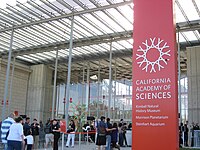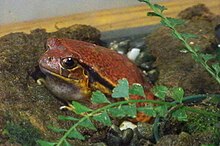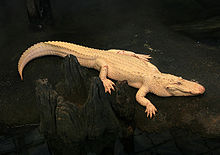California Academy of Sciences
 Entrance to the California Academy of Sciences |
|
| Data | |
|---|---|
| place | San Francisco , California |
| Art | |
| architect | Renzo Piano |
| opening | 1853 |
| Number of visitors (annually) | over a million a year |
| management |
Gregory C. Farrington
|
| Website | |
The California Academy of Sciences is an academy of science and natural history museum with a planetarium , artificial rainforest, and large aquatic area in Golden Gate Park in San Francisco , California .
The building was completely rebuilt from 2005 to 2008 and thus houses one of the most modern museums in the world. The Academy was founded in 1853 as a scientific society (hence the name). Today she still employs many scientists and carries out basic research in many areas of the natural sciences. The findings are presented and passed on in exhibitions.
Educational work
The core part of the exhibitions deals with natural history . The public parts of the exhibition are roughly divided into four parts:
- The main attraction of the newly opened Academy is the four-story man-made tropical rainforest with live fish, birds, butterflies and other animals housed in a dome .
- Steinhart Aquarium - It takes up the entire basement of the building
- Morrison Planetarium - A planetarium in the shape of a circular cinema.
- Kimball Natural History Museum - The so-called Africa Hall is part of this, which is a collection of dioramas on the animal world of Africa , as well as various temporary exhibitions on various research areas.
research
The Academy conducts research in many areas of the natural sciences. Including biology , anthropology , marine biology , botany , entomology , herpetology , ichthyology , zoology of invertebrates , mammalogy and ornithology . Also Geology has a long history in the academy, especially the paleontology as a branch of it. Today there is a strong focus on nature conservation and ecology and biodiversity .
history
Beginnings
The California Academy of Natural Sciences was founded on April 4, 1853, three years after California joined the United States . The founding members included: Henry Gibbons , MD, Albert Kellogg , MD, TJ Nevins , Esq., Andrew Randall , MD, Lewis W. Sloat , Esq., John B. Trask , MD It was the first comparable society in western Germany United States. The society's stated aim was "a complete and systematic record of every corner of the state and a collection of its rare and common products". As early as 1868, the name was changed to the more comprehensive California Academy of Sciences .
Even in the early days, the Academy had foresightedly assigned women essential tasks. Various women scientists found work in the academy as early as the 19th century, when women had few opportunities in research and science or their work was limited to secretaries or cataloging.
The first museum of its own was opened in 1874 on the corner of California Street & Dupont Street (today Grant Avenue) and already attracted 80,000 visitors a year (for comparison: San Francisco had around 150,000 inhabitants around 1870). A legacy from James Nick , a real estate mogul, entrepreneur, and philanthropist , enabled the Academy to move to a new and larger building on Market Street in 1891 . Unfortunately, this building fell victim to the severe earthquake in San Francisco , which also destroyed significant parts of the library and collections. As luck would have it, that year the first of a total of seven expeditions supported by the Academy was sent to the Galapagos Islands , which returned seven months later with a lot of new visual material and thus laid the new foundation stone for the collections.
Expansion in the 20th century
"Monarch", the last grizzly bear caught alive in California, was given to the Academy after his death in 1911 as a stuffed model. The bear served as the model for the new flag of California .
In 1916, the Academy finally moved to Golden Gate Park , where it is still today. The Steinhart Aquarium was added in 1923, and the Africa Hall followed in 1934.
During the Second World War , the Academy provided support to the American troops by repairing optical instruments and navigation equipment of the United States Navy in its workshops . Fort Mason , one of the most important embarkation points in the Pacific War , is barely three miles away.
After the war, the exhibition halls were further expanded, around 1952 with the planetarium. The core of this planetarium was a specially developed star projector that was able to project an extremely realistic image onto the "sky". The projector was able to show the stars realistically distorted instead of round like most other such projectors. Today's planetarium is fully digitized.
In the 1960s, many universities focused on new branches of science, including molecular biology, and left the (animal) collections to the Academy. In 1969 the Cowell Hall was reopened and in 1977 the so-called “fish-roundabout” a huge, round aquarium that moves around the visitor and leaves the impression of a carousel .
21st century: new building
Before the old buildings were demolished in 2005, there were exhibits on evolution and paleontology (featuring a skeleton of a Tyrannosaurus Rex to convey the reality behind Jurassic Park ), as well as gems, earthquakes, and an exhibit of Gary Larson comics who had worked at the Academy himself.
The Academy buildings were badly damaged in the 1989 Loma Prieta earthquake . Initially the bird hall was closed to the public because it was no longer safe. The Steinhart Aquarium, whose construction defects had now become visible, had also suffered considerably. During the preparation of renovation plans and construction proposals to make the buildings earthquake-proof , it turned out that this would have required a great deal of effort. So it was decided to completely demolish the old buildings and build the Academy from scratch.

On September 12, 2005, the construction machinery rolled in to begin the $ 500 million project. The exhibition was temporarily relocated to Howard Street, where it remained open to visitors. The architect for the new building was the Italian Renzo Piano . The design won the Holcim Award Silver for sustainable building. One critic described the building as a “blazing uncynical embrace of the values of the Enlightenment , truth and rationality” and a “reminder of the civilizing function of great art in a barbaric age”.
The new building is a pioneer in economical design that brings out the values of the Academy. Ecology and sustainability were central motifs in the new building, which received the highest possible award from the American Leadership in Energy and Environmental Design (LEED) program. Several major television stations broadcast programs that dealt with the Academy’s architecture. The central element of the architecture is the “living roof”, which is populated by various native plants. The green roof was chosen so that it does not require irrigation, the rainwater that occurs is collected and reused. In addition, it should be known that the region around San Francisco is very dry in summer, especially east of the Bay, practically every piece of meadow and every tree is artificially irrigated with immense effort.
The Academy reopened on September 27, 2008. Entry was free the first day, so a line of over a mile formed in front of the entrance. Not all visitors could be admitted on that day. The San Francisco Chronicle had nothing but praise for the new Academy.
architecture
The new building includes several striking ecological innovations:
- 50 percent less wastewater than before
- Use of collected rainwater for irrigation
- 60,000 photovoltaic cells
- A green roof of one hectare
- 90 percent of the exhibition space is illuminated by sunlight
- Built from 15,000 cubic meters of recycled concrete and 5,000 tons of recycled steel
- The building insulation is made from reused denim jeans
See also
Web links
- Official website
- Concrete and Strawberries - California magazine, Sept. 2008
- California Academy of Sciences at Google Cultural Institute
Individual evidence
- ^ Research . California Academy of Sciences. Archived from the original on July 10, 2012. Info: The archive link was inserted automatically and has not yet been checked. Please check the original and archive link according to the instructions and then remove this notice. Retrieved December 17, 2010.
- ^ Exhibits . California Academy of Sciences. Retrieved December 17, 2010.
- ^ Education . California Academy of Sciences. Archived from the original on July 10, 2012. Info: The archive link was inserted automatically and has not yet been checked. Please check the original and archive link according to the instructions and then remove this notice. Retrieved December 17, 2010.
- ^ Rainforests of the World . California Academy of Sciences. Archived from the original on January 27, 2009. Info: The archive link was automatically inserted and not yet checked. Please check the original and archive link according to the instructions and then remove this notice. Retrieved January 7, 2009.
- ^ The Monarch Bear . The Monarch Bear Institute. Retrieved July 9, 2009.
- ↑ Lisa Rochon: Source surprise! Uber-building shutout; A low-income housing project in Montreal has won a prestigious prize . In: The Globe and Mail . , Toronto October 6, 2005, p. R3.
- ↑ Nicolai Ouroussoff: A Building That Blooms and Grows, Balancing Nature and Civilization . In: The New York Times . September 23, 2008. Retrieved December 17, 2010.
- ^ New California Academy of Sciences Receives Highest Possible Rating from US Green Building Council: LEED Platinum . California Academy of Sciences. October 8, 2008. Archived from the original on January 21, 2009. Info: The archive link was automatically inserted and has not yet been checked. Please check the original and archive link according to the instructions and then remove this notice. Retrieved January 7, 2009.
- ^ Extreme Engineering , California Academy of Sciences; on Discovery Channel on August 11, 2006
- ↑ National Geographic Channel , Hi-Tech Museum ( Memento of the original from July 25, 2008 in the Internet Archive ) Info: The archive link was inserted automatically and has not yet been checked. Please check the original and archive link according to the instructions and then remove this notice. , shown on July 17, 2008
- ^ David Perlman: Mile-long line for Academy of Sciences opening . In: San Francisco Chronicle , September 28, 2008. Retrieved January 7, 2009.
- ↑ Eric Simons: Concrete and strawberries . In: University of California Alumni Association (Ed.): California . , Pp. 52-53. Retrieved November 26, 2018.
- ↑ Mike Chino: The New Green California Academy of Sciences Unveiled! . In: Inhabit . September 22, 2008. Retrieved December 17, 2010.
Coordinates: 37 ° 46 '12.4 " N , 122 ° 27' 59.1" W.






